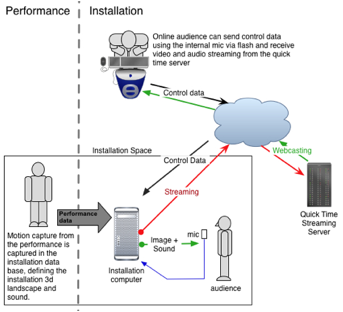.../// [C0D3]
|
- Parallelism between magic spells and computer code |
 |
[C0D3] was triggered by a performance that conceptually and technically gave birth to the piece. The motion generated by the performance is captured through a pair of home made data gloves and translated into numerical information that defines a 3D landscape, visualizations and sounds. The resulting virtual spaces and objects are thus a graphical re-presentation of the physical body - the user generating the movement - and time. These virtual spaces became a gathering place for the virtual representation of users, who would navigate them using their voice. [C0D3] could also be interacted with through an online platform. The piece is a take on the theme of Disembodiment: our virtual existences happen without our physical body and through body-extensions. It highlights the relation between shamanism and virtuality, between incantations and computer code: how a certain combination of symbols - letters, words or code - pronounced on one level of reality will affect another. An important moment of our evolution towards telepathy, on the path to perfect communication highways, is the fusion of word and action. The virtual reality where we spend a considerable amount of our daily lives is driven by a new sort of "... magic word: the commands you type into a computer are a kind of speech that doesn't so much communicate as make things happen. They are incantations, in other words, and anyone at all attuned to the techno-social megatrends of the moment -- from the growing dependence of economies on the global flow of intensely fetishized words and numbers to the burgeoning ability of bioengineers to speak the spells written in the four-letter text of DNA -- knows that the logic of the incantation is rapidly permeating the fabric of our lives." (Julian Dibbel[1])
[C0D3] was conceived as a "Time Mixer"; different moments in time gather together in its virtual space: online user; server; real time processing of data; stream. These are all concepts analyzed in HCI research. [C0D3] highlights the physical distance that separates these different entities integrating a certain delay into the equation, and thus draws attention to the `extensiveness´ still present in the `intensive´ time of our virtual exchanges nowadays (Paul Virilio [2]). |
|
The physical relation - Gestural Control - with machines happens through low-tech motion-capture devices such as data gloves. [C0D3] users, online and in FACT's Media Lounge, could also interact with the piece using their voice. The information received from the capture devices - data gloves and microphones (in situ and online) - is analysed and mapped onto the 3D landscapes and sounds. A set of MaxMSP patches triggers these organic 3D visualizations and sounds. This generative installation will continue to grow for as long as it receives input from users. ..// Credits
Additional PHP programming: Josh Nimoy. |
Co-commissioned by FACT (Foundation for Art and Creative Technology) and Liverpool John Moores University School of Computing and Mathematical Sciences, made possible by a Partnership for Public Awareness grant from the Engineering and Physical Sciences Research Council (EPSRC). |
[1] Julian Dibbel: "A Rape in Cyberspace", first appeared in The Village Voice, New York, Dec. 1993. |
